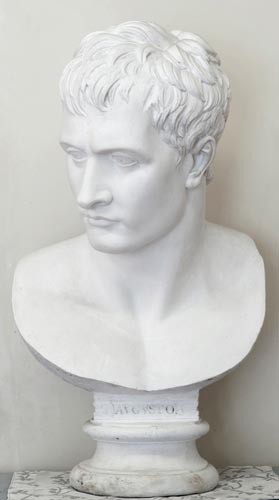This plaster bust is one of a series of portraits produced by Canova between 1802 and 1822, each with varying degrees of success. More generally, the bust is also part of a wider collection of inter-connected works, the establishment of the provenance of which however remains to a certain extent inconclusive. These works are still being explored and studied at the Museo Canova in the sculptor’s hometown of Possagno. The creative evolution behind this particular item is fascinating, a near-perfect portrait that maps Napoleon’s changing priorities, and thus mirrors the Corsican’s political evolution.
Antonio Canova had initially been invited to Paris to complete a portrait of the First Consul in uniform (plaster cast versions of which exist in the Possagno gypsotheca and at the Accademia di San Luca in Rome). A classical-style bust was subsequently completed based on this initial work, and this would serve as an intermediary between the portrait of Napoleon in consular dress and the colossal marble statue produced in 1806 depicting the French emperor as Mars the Peacemaker, today in Apsley House, London (a bronze version of this statue was also made in 1809, which now stands in the Accademia di Brera, in Milan). Although the marble bust – the basis for this plaster cast – is today part of the Devonshire Collection in Chatsworth, it did not leave the sculptor’s workshop until after his death. It was only then that Canova’s half-brother, Abbot Sartori, sold the bust to the Marchesa di Aubercorn, who subsequently bequeathed it to the Duke of Devonshire. A large number of copies were made, and whilst many are of uncertain provenance, those held in the State Hermitage Museum in St Petersburg and the Gallery of Modern Art in Florence – both from the sculptor’s workshop – are worth mentioning.
This particular bust depicts Napoleon in idealised form, similar in appearance to a Roman emperor. Indeed, the bust’s plaque bears the inscription “AVGUSTO”. The work was acquired by the Museo Glauco Lombardi in 2007, along with a plaster bust of Marie-Louise, which is identical to the marble version held in the Biblioteca Palatina in Parma. The two plaster busts originally belonged to Paolo Toschi (1788-1854), the famous Italian draughtsman and engraver who was also director of the Accademia di Belle Arti di Parma, artistic adviser to the king, and founder of the ducal city’s acclaimed engraving workshop. The artists probably met during Toschi’s schooling in Paris between 1809 and 1819, and it is thus highly likely that the two busts came direct from the sculptor’s workshop. It is also likely that Canova and Toschi saw each other once again in 1815, when a large number of works from the Musée Napoléon (today the Louvre) were returned to their original homes.
The bust’s features were initially hidden by multiple layers of distemper – a modification which had also removed the original patina – but the restoration project completed just after the bust’s acquisition revealed the incredible quality of the plaster copy. The bust rear also appears to be incomplete, suggesting that the work was never finished.
Francesca Sandrini, July 2012 (trad. H.D.W.)
This work was on show at the National Gallery of Victoria, Melbourne, (Australia) as part of the exhibition Napoléon. Revolution to Empire (from June to October 2012)
For more on the Museo Glauco Lombardi, visit their site.


